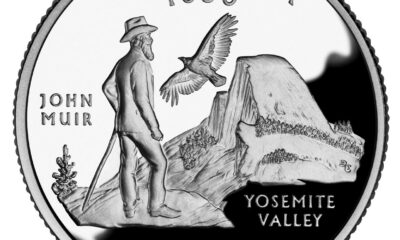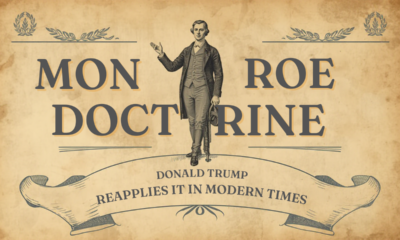Executive
Credit Card Rate Caps Could Hurt Those Most In Need of Credit
A bread-and-butter economist warns President Donald Trump NOT to propose to cap credit card interest rates.

American households are scaling a mountain of credit card debt, thanks to the inflation affordability crisis brought to us by the Biden-Harris administration. Former President Donald Trump has proposed capping interest rates that consumers pay on their credit cards to 10% to provide them with temporary relief. History tells us that good intentions can still lead to negative outcomes. Past efforts to cap interest rates on other financial products have backfired on low-income consumers in unexpected ways. We would not want the same to happen with credit cards.
Current state of credit card balances
Credit card balances reached a record high of $1.14 trillion in Q2 of 2024, according to the Federal Reserve Bank of New York. Credit card balances shot up not long after the inflationary American Rescue Plan was enacted. Since 2021, the average credit card borrower’s balance rose from $4,828 to $6,329.
The average credit card interest rate is 20.65%, down slightly from an August 2024 record-high 20.79%. The Federal Reserve’s recent 50-basis point cut to the federal funds rate and future rate cuts will likely pull credit card interest rates down. Frustratingly for bill-paying households, credit card rates may drift downward slowly rather than plunge quickly.
President Trump said at a rally recently, “While working Americans catch up, we’re going to put a temporary cap on credit card interest rates. We can’t let them make 25 and 30%.”
While we don’t know the details of such a plan, we do know from states that have enacted rate cap bills on consumer loans—also called “small-dollar loans,” “installment loans,” or more derogatorily “payday loans”—that consumers with the fewest means lose access to credit, leaving them to use costly—even dangerous—alternatives.
History of past rate-cap proposals
Democrats in Washington have tried to cap interest rates many times. Vermont Sen. Bernie Sanders and New York Rep. Alexandria Ocasio-Cortez proposed a sweeping 15% federal cap on interest rates for credit cards and consumer loans in 2019. Senate Banking Committee Chairman Sherrod Brown (D-Ohio) and fellow Democrats introduced a national interest rate cap of 36% in 2021 on consumer loans. Last year, liberals were joined by a Republican in their quest to impose rate controls. Sen. Josh Hawley (R-Mo.) introduced an 18% interest rate cap on credit cards.
In theory, these rate caps sound like a lifeline to borrowers struggling with debt. In reality, they are an anchor that sinks those who need access to credit the most. Small-dollar loan borrowers tend to come from lower-income households that are less-educated, younger, non-Asian minorities, and have volatile incomes. Many lack access to traditional banking services and depend on short-term loans. They may have spotty credit histories or pose a higher risk of default.
Results? Don’t ask!
In states that have enacted lending rate caps, the results were terrible for these low-income borrowers. According to research by the Federal Reserve Bank of New York, after enacting a rate cap in Georgia, borrowers bounced 1.2 million more checks per year, paying an extra $36 million per year in bounced check fees; complaints about lenders and debt collectors rose 64%; and more borrowers filed for Chapter 7 bankruptcy. Similar results occurred in North Carolina.
More recently, in 2021, Illinois capped installment loans under $40,000 from non-bank and non-credit-union lenders at 36%. Consequently, according to academic research, high-risk borrowers were cut off from access to credit, costs increased, and consumers were left worse off financially.
Capping interest rates is a strategy that restricts the supply of credit. Proponents hold up eye-popping interest rates as evidence of predatory lending. However, as economists will tell you, the effective APR is not what borrowers think about when taking loans out but the total cost of borrowing, including fees, compared to other alternatives. As Thomas Sowell opined, “Using this kind of reasoning—or lack of reasoning—you could … say a hotel room rents for $36,000 a year, [but] few people stay in a hotel room all year.”
Credit card access threatened
High interest rates serve a purpose. They cover the risks of giving credit to risky borrowers. Historically, when policies restricted access to legal forms of credit, consumers were driven to more unsavory options, such as loan sharks that thrived in a black market for credit. Today, credit cards are a common source of revolving credit, and most households have them.
Granted, credit card balances are high due to inflation and high interest rates. However, capping interest rates on credit cards will not affect all borrowers the same. It might help those who carry low balances and have good credit, but higher-risk borrowers will likely lose access to credit such as lowered credit limits or canceled cards. That leaves them with fewer and worse options when an unexpected expense hits.
At a time when Americans are using credit to maintain their standard of living or cope with an unforeseen expense, we should be careful not to implement well-intentioned credit-limiting policies that would leave households–especially minority and low-income—worse off.
This article was originally published by RealClearMarkets and made available via RealClearWire.
Patrice Onwuka is the director of the Center for Economic Opportunity at Independent Women’s Forum, and a Philanthropy Roundtable Adjunct Senior Fellow.
-

 Executive1 day ago
Executive1 day agoWaste of the Day: Can You Hear Me Now? No.
-

 Civilization1 day ago
Civilization1 day agoTrump’s version of the Monroe Doctrine
-

 Civilization5 days ago
Civilization5 days agoTen Reasons To Cheer the Arrest of Maduro
-

 Civilization3 days ago
Civilization3 days agoOne Fell Swoop: Lawsuit Eyes Death Blow to Racial Preferences
-

 Civilization2 days ago
Civilization2 days agoTrump’s New Doctrine of Precision Deterrence
-

 Civilization22 hours ago
Civilization22 hours agoThe Snatch and Grab of Maduro Was Not ‘Illegal’
-

 Civilization21 hours ago
Civilization21 hours agoThe Mission to Extradite Nicholas Maduro
-

 Executive3 days ago
Executive3 days agoWaste of the Day: $1.6T in Wasteful Spending in Rand Paul’s “Festivus” Report






